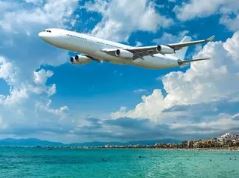To avoid altitude-induced DCS, how long should you wait to fly after scuba diving — 12 hours? 24 hours? The guidelines may surprise you.
So What’s the Big Deal About Flying After Diving?
In a word, the deal is DCS. You already know that your body must have adequate time during an ascent to off-gas excess nitrogen or you can form bubbles in your bloodstream, possibly leading to DCS. Same for an ascent in an airplane to a lesser atmosphere of pressure-excess nitrogen can bubble out if there’s too much of it still left.
But Aren’t Airplane Cabins Pressurized?
Yes, they are, but only to the equivalent of approximately 8,000 feet. That’s still a pressure decrease from sea level of 25 percent. If your body is already off-gassing at sea level as fast as it can, this sudden decrease in pressure could be enough to trigger symptoms of DCS.
So How Long Should I Wait Before Flying?
In 2002, DIvers Alert Network and the Hyperbaric Medical Society held a workshop to review data on post-dive flights. The recommendations are below:
DIVE PROFILE MIN. TIME BEFORE FLIGHT
Single No-Deco Dive 12+ Hours
Multiple Dives in a Day 18+ Hours
Multiple Days of Diving 18+ Hours
Decompression Diving Substantially more than 24 Hours
Time for the bad news: Having a zero percent risk of DCS is possible only if you don’t dive. The good news: Past analyses of accident data do provide some guidelines that divers can use to make a reasonable decision. If you’ve only done one dive a day for several days during your vacation, a wait of 18 hours is probably sufficient. However, the more multiple dive days you’ve had, and especially if you’ve done required decompression diving, the longer past 18 hours you should wait. Most researchers believe that a 24-hour surface interval is sufficient to prevent most incidences of flying-induced DCS.
Won’t My Dive Computer Tell Me When It’s Safe To Fly?
Maybe, maybe not. Dive computers can be useful tools when dealing with flying after diving, but most are not. Different computers have two ways of dealing with flight:
Arbitrary countdowns of 12 or 24 hours. These are simply clocks reminding you of the 12- or 24-hour rules; they perform no calculations.
Calculation to desaturation. These computers actually calculate the time to total desaturation and use that as the time to fly. Very conservative, but more realistic than the arbitrary 12 to 24 hour timekeepers.
Most dive computer manufacturers have taken the easy, less effective way out by simply using the arbitrary countdown as the time to fly. It seems amazing with all the calculations that dive computers can do under water, that all they can do on the surface is count minutes.
Whatever data is provided by a dive computer, that data needs to be read, understood and acted on by the user. You should understand that dive computers will not violate or make any adjustments for not following their time-to-fly readings.
Source: sport diver







